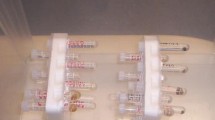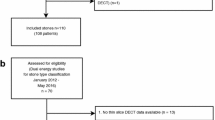Abstract
Purpose
Oral chemolysis is an effective and non-invasive treatment for uric acid urinary stones. This study aimed to classify urinary stones into either pure uric acid (pUA) or other composition (Others) using non-contrast-enhanced computed tomography scans (NCCTs).
Methods
Instances managed at our institution from 2019 to 2021 were screened. They were labeled as either pUA or Others based upon composition analyses, and randomly split into training or testing data set. Several instances contained multiple NCCTs which were all collected. In each of NCCTs, individual urinary stone was treated as individual sample. From manually drawn volumes of interest, we extracted original and wavelet radiomics features for each sample. The most important features were then selected via the Least Absolute Shrinkage and Selection Operator for building the final model on a Support Vector Machine. Performance on the testing set was evaluated via accuracy, sensitivity, specificity, and area under the precision–recall curve (AUPRC).
Results
There were 302 instances, of which 118 had pUA urinary stones, generating 576 samples in total. From 851 original and wavelet radiomics features extracted for each sample, 10 most important features were ultimately selected. On the testing data set, accuracy, sensitivity, specificity, and AUPRC were 93.9%, 97.9%, 92.2%, and 0.958, respectively, for per-sample prediction, and 90.8%, 100%, 87.5%, and 0.902, respectively, for per-instance prediction.
Conclusion
The machine learning algorithm trained with radiomics features from NCCTs can accurately predict pUA urinary stones. Our work suggests a potential assisting tool for stone disease treatment selection.



Similar content being viewed by others
Data availability
Data are available for bona fide researchers who request it from the authors.
Abbreviations
- 95CI:
-
95% Confidence interval
- AUPRC:
-
Area under the precision–recall curve
- AUROC:
-
Area under the receiver operating characteristic curve
- CT:
-
Computed tomography
- CV:
-
Cross validation
- DECT:
-
Dual-energy computed tomography
- FTIR:
-
Fourier transform infrared spectroscopy
- HU:
-
Hounsfield unit
- LASSO:
-
Least absolute shrinkage and selection operator
- NCCT:
-
Non-contrast-enhanced computed tomography
- PRC:
-
Precision–recall curve
- ppLapl:
-
Peak point Laplacian
- PPV:
-
Positive predictive value
- pUA:
-
Pure uric acid
- VOI:
-
Volume of interest
- SECT:
-
Single-energy computed tomography
- SVM:
-
Support vector machine
- UA:
-
Uric acid
References
Liu Y, Chen Y, Liao B, Luo D, Wang K, Li H et al (2018) Epidemiology of urolithiasis in Asia. Asian J Urol 5(4):205–214
Abufaraj M, Xu T, Cao C, Waldhoer T, Seitz C, D’andrea D et al (2021) Prevalence and trends in kidney stone among adults in the USA: analyses of national health and nutrition examination survey 2007–2018 data. Eur Urol Focus 7(6):1468–1475
Türk C, Petrik A, Seitz C, Neisius A, Skolarikos A (2022) EAU Guidelines on Urolithiasis. In: EAU Guidelines (Edn). Presented at the EAU Annual Congress Amsterdam
Pearle MS, Goldfarb DS, Assimos DG, Curhan G, Denu-Ciocca CJ, Matlaga BR et al (2014) Medical management of kidney stones: AUA guideline. J Urol 192(2):316–324
Spettel S, Shah P, Sekhar K, Herr A, White MD (2013) Using hounsfield unit measurement and urine parameters to predict uric acid stones. Urology 82(1):22–26
Qin L, Zhou J, Hu W, Zhang H, Tang Y, Li M (2022) The combination of mean and maximum Hounsfield Unit allows more accurate prediction of uric acid stones. Urolithiasis. https://doi.org/10.1007/s00240-022-01333-2
Gillies RJ, Kinahan PE, Hricak H (2016) Radiomics: images are more than pictures. They Are Data Radiol 278(2):563–577
Choy G, Khalilzadeh O, Michalski M, Do S, Samir AE, Pianykh OS et al (2018) Current applications and future impact of machine learning in radiology. Radiology 288(2):318–328
Vamathevan J, Clark D, Czodrowski P, Dunham I, Ferran E, Lee G et al (2019) Applications of machine learning in drug discovery and development. Nat Rev Drug Discov 18(6):463–477
Peiffer-Smadja N, Rawson TM, Ahmad R, Buchard A, Georgiou P, Lescure FX et al (2020) Machine learning for clinical decision support in infectious diseases: a narrative review of current applications. Clin Microbiol Infect 26(5):584–595
Mitchell TM (1997) Machine learning. McGraw-Hill, New York, p 414 (McGraw-Hill series in computer science)
Lidén M (2018) A new method for predicting uric acid composition in urinary stones using routine single-energy CT. Urolithiasis 46(4):325–332
Ganesan V, De S, Shkumat N, Marchini G, Monga M (2018) Accurately diagnosing uric acid stones from conventional computerized tomography imaging: development and preliminary assessment of a pixel mapping software. J Urol 199(2):487–494
Celik S, Sefik E, Basmacı I, Bozkurt IH, Aydın ME, Yonguc T et al (2018) A novel method for prediction of stone composition: the average and difference of Hounsfield units and their cut-off values. Int Urol Nephrol 50(8):1397–1405
Marchini GS, Remer EM, Gebreselassie S, Liu X, Pynadath C, Snyder G et al (2013) Stone characteristics on noncontrast computed tomography: establishing definitive patterns to discriminate calcium and uric acid compositions. Urology 82(3):539–546
Fedorov A, Beichel R, Kalpathy-Cramer J, Finet J, Fillion-Robin JC, Pujol S et al (2012) 3D Slicer as an image computing platform for the Quantitative Imaging Network. Magn Reson Imaging 30(9):1323–1341
Eisner BH, Kambadakone A, Monga M, Anderson JK, Thoreson AA, Lee H et al (2009) Computerized tomography magnified bone windows are superior to standard soft tissue windows for accurate measurement of stone size: an in vitro and clinical study. J Urol 181(4):1710–1715
Danilovic A, Rocha BA, Marchini GS, Traxer O, Batagello C, Vicentini FC et al (2019) Computed tomography window affects kidney stones measurements. Int Braz J Urol 45(5):948–955
van Griethuysen JJM, Fedorov A, Parmar C, Hosny A, Aucoin N, Narayan V et al (2017) Computational radiomics system to decode the radiographic phenotype. Cancer Res 77(21):e104–e107
Saito T, Rehmsmeier M (2015) The precision-recall plot is more informative than the ROC plot when evaluating binary classifiers on imbalanced datasets Brock G editor. PLoS ONE 10(3):0118432
Becker G (2007) Uric acid stones. Nephrology 12(s1):S21–S25
Jendeberg J, Thunberg P, Popiolek M, Lidén M (2021) Single-energy CT predicts uric acid stones with accuracy comparable to dual-energy CT—prospective validation of a quantitative method. Eur Radiol 31(8):5980–5989
Kim J, Cho K, Kim D, Chung D, Jung H, Lee J (2019) Predictors of uric acid stones: mean stone density, stone heterogeneity index, and variation coefficient of stone density by single-energy non-contrast computed tomography and urinary pH. J Clin Med 8(2):243
Zhang GMY, Sun H, Shi B, Xu M, Xue HD, Jin ZY (2018) Uric acid versus non-uric acid urinary stones: differentiation with single energy CT texture analysis. Clin Radiol 73(9):792–799
Wang Z, Yang G, Wang X, Cao Y, Jiao W, Niu H (2023) A combined model based on CT radiomics and clinical variables to predict uric acid calculi which have a good accuracy. Urolithiasis 51(1):37
Acknowledgements
This study was supported by Institute of Information & communications Technology Planning & Evaluation (IITP) under the Artificial Intelligence Convergence Innovation Human Resources Development (IITP-2023-RS-2023-00256629) grant funded by the Korea government (MSIT) and grants from the Ministry of Education, Republic of Korea (NRF-2022R1I1A3072856 to Ilwoo Park and NRF-2021R1I1A3060723 to Byung H. Baek) and Chonnam National University Hospital Biomedical Research Institute (BCRI22037 to Ilwoo Park).
Funding
This study was supported by Institute of Information & communications Technology Planning & Evaluation (IITP) under the Artificial Intelligence Convergence Innovation Human Resources Development (IITP-2023-RS-2023-00256629) Grant funded by the Korea government (MSIT) and grants from the Ministry of Education, Republic of Korea (NRF-2022R1I1A3072856 to Ilwoo Park and NRF-2021R1I1A3060723 to Byung H. Baek) and Chonnam National University Hospital Biomedical Research Institute (BCRI22037 to Ilwoo Park).
Author information
Authors and Affiliations
Contributions
BD Le: conceptualization, methodology, formal analysis, writing—original draft, review and editing. AT Nguyen: methodology, formal analysis. BH Baek: supervision, funding acquisition. KJ Oh: resources, conceptualization, methodology, supervision, funding acquisition, writing—review and editing. I Park: conceptualization, methodology, supervision, funding acquisition, project administration, writing—original draft, review and editing.
Corresponding authors
Ethics declarations
Conflict of interest
The authors have no competing interests to declare that are relevant to the content of this article.
Ethics approval
Approval was obtained from the institutional review board (IRB No. 2022–434) of Chonnam National University Hospital. The procedures used in this study adhere to the tenets of the Declaration of Helsinki.
Research involving human participants and/or animals
No animals or human participants were required for this study.
Informed consent
Informed consent was waived by the institutional review board as this study is a retrospective analysis of imaging.
Additional information
Publisher's Note
Springer Nature remains neutral with regard to jurisdictional claims in published maps and institutional affiliations.
Supplementary Information
Below is the link to the electronic supplementary material.
Rights and permissions
Springer Nature or its licensor (e.g. a society or other partner) holds exclusive rights to this article under a publishing agreement with the author(s) or other rightsholder(s); author self-archiving of the accepted manuscript version of this article is solely governed by the terms of such publishing agreement and applicable law.
About this article
Cite this article
Le, B.D., Nguyen, T.A., Baek, B.H. et al. Accurate prediction of pure uric acid urinary stones in clinical context via a combination of radiomics and machine learning. World J Urol 42, 150 (2024). https://doi.org/10.1007/s00345-024-04818-4
Received:
Accepted:
Published:
DOI: https://doi.org/10.1007/s00345-024-04818-4




